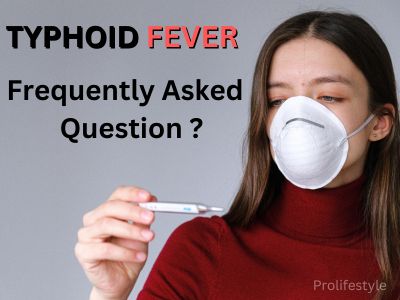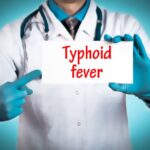
Typhoid fever also known as enteric fever, is a serious infectious disease caused by the bacterium Salmonella enterica serotype Typhi. It is a global health concern, particularly in regions with inadequate sanitation and limited access to clean water. Typhoid fever is primarily transmitted through the ingestion of contaminated food and water or through close contact with infected individuals. Once inside the body, the Salmonella Typhi bacteria multiply and spread throughout the bloodstream, affecting various organs and systems. The typical symptoms of typhoid fever include high fever, headache, fatigue, abdominal pain, and a characteristic rash known as “rose spots.” Patients may also experience gastrointestinal symptoms such as diarrhea or constipation. If left untreated, typhoid fever can lead to severe complications, such as intestinal perforation, gastrointestinal bleeding, or infection spreading to other organs. Typhoid fever can be diagnosed through blood cultures or other laboratory tests to identify the presence of Salmonella Typhi bacteria.
Treatment of typhoid fever usually involves the use of antibiotics to eliminate the bacteria. However, the emergence of antibiotic-resistant strains of Salmonella Typhi poses a challenge to treatment. Prevention strategies include vaccination, practicing good hygiene and sanitation, and avoiding the consumption of contaminated food and water. Efforts to control typhoid fever involve improving access to clean water, promoting proper sanitation, and raising awareness about hygiene practices. In regions where typhoid fever is endemic, vaccination campaigns targeting high-risk populations can help reduce the disease burden.
Are typhoid and yellow fever the same ?
No, typhoid fever and yellow fever are not the same. They are two distinct infectious diseases caused by different pathogens. Typhoid fever, also known as enteric fever, is caused by the bacterium Salmonella enterica serotype Typhi. It is mostly transmitted through contaminated food and water. Typhoid fever affects the digestive system and can cause symptoms such as high fever, headache, abdominal pain, and diarrhea. Typhoid fever can be prevented through vaccination and by practicing good hygiene and sanitation.
Yellow fever on the other hand, is a viral disease caused by the yellow fever virus, which is transmitted by mosquitoes. It primarily occurs in tropical and subtropical areas of Africa and South America. Yellow fever can cause a wide range of symptoms, including fever, headache, muscle and joint aches, nausea, and jaundice (yellowing of the skin and eyes). Vaccination is available for yellow fever and is recommended for individuals traveling to areas where the disease is endemic.
While both diseases can result in severe illness and are associated with fever, they are caused by different pathogens and have distinct modes of transmission. It’s important to differentiate between them for accurate diagnosis, treatment, and prevention strategies.
What is the best food for typhoid patient ?
During the recovery period from typhoid fever, it is important for patients to consume a balanced and nutritious diet to help regain strength and support the healing process. Here are some food recommendations for typhoid patients:
- Soft, easily digestible foods : Start with a diet consisting of easily digestible foods such as boiled rice, boiled potatoes, steamed vegetables, and well-cooked, lean meats like chicken or fish.
- Broths and soups : Warm, clear broths and soups can provide hydration and nutrients. Chicken soup or vegetable broth can be soothing and nourishing.
- Fruits and vegetables : Once the initial phase of recovery is over, introduce soft, cooked fruits like apples and pears . Well-cooked vegetables, such as carrots and green beans, are also beneficial.
- Yogurt : Probiotic-rich yogurt can help restore the healthy gut flora. Choose plain, unsweetened yogurt.
- Whole grains : Gradually introduce whole grains like oatmeal, whole wheat bread, and brown rice to provide energy and fiber.
- Adequate fluids : Hydration is crucial during recovery. Drink plenty of clean, purified water, as well as electrolyte-rich fluids like coconut water, herbal teas, or oral rehydration solutions.
Can amoxicillin treat typhoid fever ?
Amoxicillin is not typically the first-line antibiotic used to treat typhoid fever caused by the bacterium Salmonella enterica serotype Typhi. The choice of antibiotics for treating typhoid fever depends on several factors, including the local resistance patterns of the bacteria.
The current recommended antibiotics for treating typhoid fever include fluoroquinolones such as :
- Ciprofloxacin,
- Ceftriaxone,
- Azithromycin.
These antibiotics are more effective in treating the specific strains of Salmonella Typhi that cause typhoid fever and have demonstrated good efficacy.
Amoxicillin, a member of the penicillin family of antibiotics, may not be as effective against Salmonella Typhi due to the high prevalence of drug resistance in this bacterium. However, in some cases where the strain of Salmonella Typhi is sensitive to amoxicillin, it may be used as an alternative treatment option.
It is crucial to consult with a healthcare professional for an accurate diagnosis and appropriate treatment of typhoid fever. The healthcare professional will prescribe the most effective antibiotic to ensure effective treatment and minimize the risk of complications.
Which typhoid is more dangerous ?
Both “Typhoid fever” and “Paratyphoid fever” are caused by bacteria of the Salmonella genus and can lead to serious illness if left untreated. However, when comparing the two, typhoid fever caused by Salmonella enterica serotype Typhi is generally considered more dangerous than paratyphoid fever caused by Salmonella enterica serotypes Paratyphi A, B, or C.
Typhoid fever tends to have a higher morbidity and mortality rate compared to paratyphoid fever. It can result in severe complications, such as intestinal perforation, gastrointestinal bleeding, or infection spreading to other organs, which can be life-threatening. Typhoid fever is also known to have a higher incidence of severe systemic symptoms, including sustained high fever, severe headache, and gastrointestinal symptoms.
Paratyphoid fever while still a serious illness, generally presents with milder symptoms and a lower risk of severe complications compared to typhoid fever. The clinical manifestations of paratyphoid fever may resemble those of typhoid fever, but they tend to be less severe and have a shorter duration. The overall prognosis for paratyphoid fever is typically better, with a lower risk of serious complications and a faster recovery.
It’s important to note that the severity and clinical outcomes of both typhoid and paratyphoid fevers can vary among individuals and depend on factors such as the patient’s overall health, access to healthcare, and timely initiation of appropriate treatment. Early diagnosis, prompt medical care, and appropriate antibiotic therapy are vital in managing both typhoid and paratyphoid fevers effectively.
Typhoid can be cured in how many days ?
In general, the treatment for typhoid fever involves a course of antibiotics to eliminate the Salmonella Typhi bacteria from the body. The duration of antibiotic treatment typically ranges from 7 to 14 days, depending on the specific antibiotic prescribed and the response to treatment. The duration of typhoid fever can vary from person to person and depends on various factors, including the individual’s overall health, the severity of the infection, and timely initiation of appropriate treatment
While antibiotics help in clearing the infection, complete recovery from typhoid fever may take several weeks. It is common for patients to experience a gradual improvement in symptoms over time. Fatigue and weakness may persist for a period after the acute illness, and it may take some time for the body to regain full strength.
It is essential to continue taking the prescribed antibiotics for the entire course, even if the symptoms improve or disappear, to ensure complete eradication of the bacteria and prevent relapse. Regular follow-up visits with a healthcare professional are important to monitor the progress of recovery and make any necessary adjustments to the treatment plan.
It’s important to consult with a healthcare professional for an accurate diagnosis, appropriate treatment, and guidance on the expected duration of recovery based on individual circumstances.
Can azithromycin treat typhoid fever ?
Yes, azithromycin is one of the recommended antibiotics for treating typhoid fever caused by Salmonella enterica serotype Typhi. It is an effective treatment option, particularly in areas where there is a high prevalence of antibiotic resistance to other commonly used drugs.
Azithromycin belongs to the class of antibiotics known as macrolides and works by inhibiting bacterial protein synthesis, thus effectively eliminating the Salmonella Typhi bacteria.
Azithromycin has demonstrated good efficacy in the treatment of typhoid fever and is often used as a first-line or alternative treatment option. However, it is important to note that the choice of antibiotic should be based on several factors, including the local resistance patterns of the bacteria. In some cases, other antibiotics such as fluoroquinolones or third-generation cephalosporins may be preferred depending on the specific circumstances and resistance patterns.
It is crucial to consult with a healthcare professional for an accurate diagnosis and appropriate treatment of typhoid fever.


